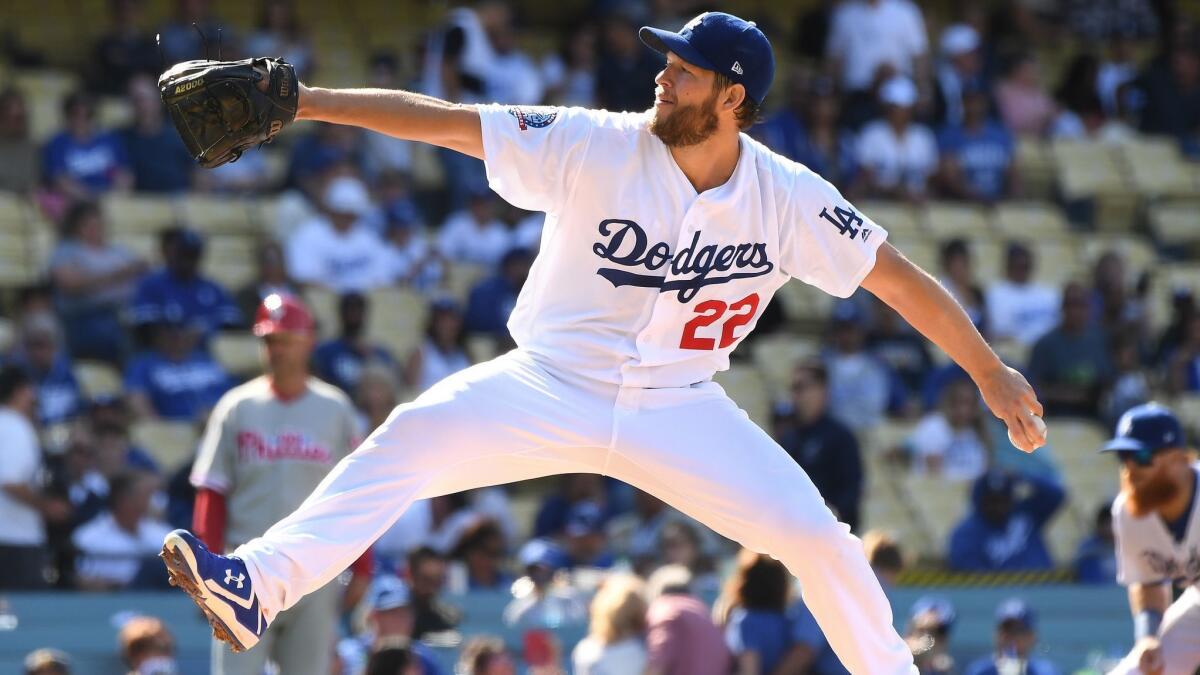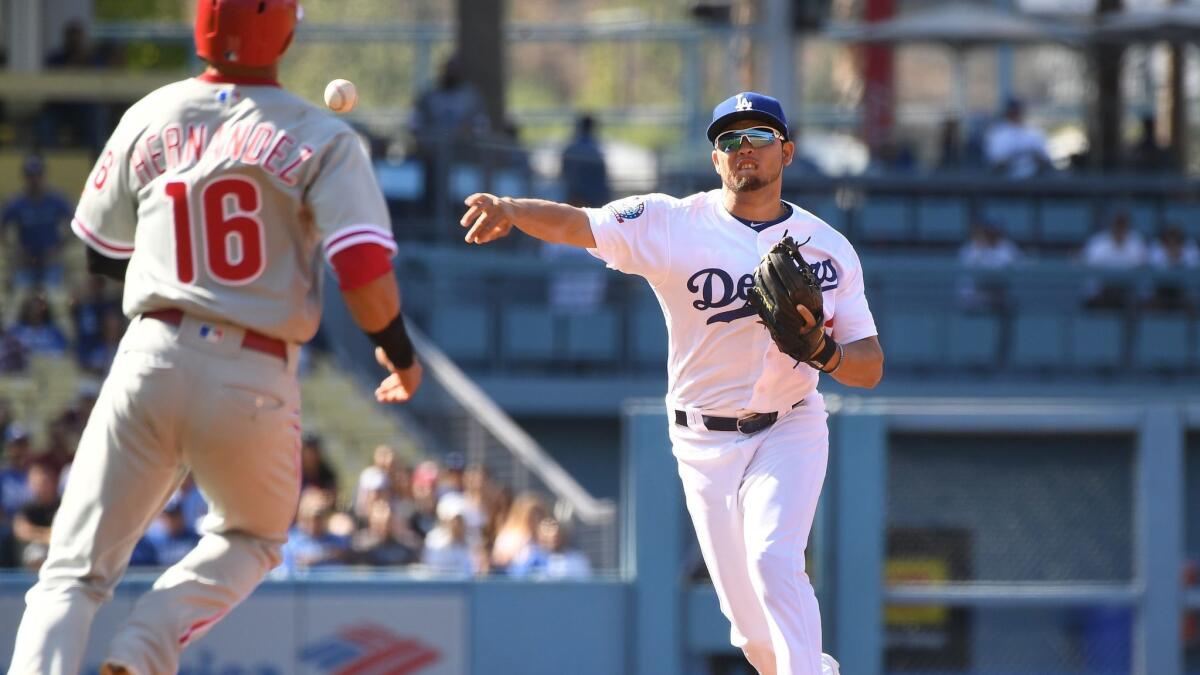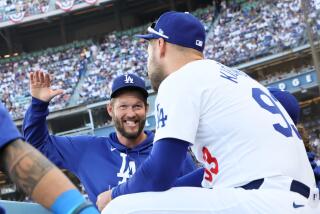Dodgers’ Clayton Kershaw will have MRI after back tightens in return from arm injury

- Share via
Clayton Kershaw’s highly anticipated return to the Dodgers’ rotation may be more of a cameo appearance.
The ace left Thursday’s 2-1 loss to the Philadelphia Phillies after throwing 62 pitches over five ho-hum but effective innings because of tightness in his troublesome lower back, an injury that further clouds the future of one of baseball’s best pitchers and the playoff hopes of the team that employs him.
Kershaw, who sat out the last month because of biceps tendinitis, did not fly with the Dodgers to Colorado on Thursday night. He will undergo an MRI test Friday, and the chances of the left-hander returning to the disabled list appear high.
“With Clayton’s history, there’s obviously some concern,” manager Dave Roberts said. “You want to make sure he’s well and good, so we’re gonna dig into it, see if there’s anything to it … but right now, we don’t know.”
Kershaw, 30, missed 10 weeks of the 2016 season because of a herniated disk in his lower back and five weeks of 2017 because of a lower-back strain, returning to pitch in the playoffs both years.
“The 2016 injury is entirely different — I think that was very, very severe,” said Kershaw, a three-time Cy Young Award winner. “If I could compare it to anything it would be to last year. It might not be that bad. I don’t know right now. It’s just tightness. That’s the best way I can describe it.”

It was a dismal all-around day for the Dodgers, who failed to notice that Maikel Franco did not touch home plate while scoring on Jorge Alfaro’s second-inning single, an oversight that cost them a run, and had right fielder Yasiel Puig lose Alfaro’s seventh-inning RBI double to right-center in the twilight.
Though Kershaw gave up one run and four hits in five innings, striking out five and walking one, his fastball velocity dipped from 90-mph in the first inning to 87-88 mph by the fourth.
He averaged 91.1 mph in his first seven starts this season and 93.1 mph over his 11-year career, according to Fangraphs.
“Everything ticked down a little bit,” Roberts said. “When you look at 90 mph early and then you see it [dip] as the game progresses … in that fourth and fifth inning, that’s when it really showed itself.”
Kershaw, who did not make a minor league rehab start, said his shoulder felt fine. His mechanics were so sound that catcher Yasmani Grandal couldn’t even tell Kershaw was hurting.
“Usually when things go bad, you see the delivery getting out of whack,” Grandal said, “but not at any point did I see that.”
Kershaw needed 26 pitches to complete his final three scoreless innings, and he struck out the side — Alfaro looking at a slider, pitcher Aaron Nola swinging at a slider and Cesar Hernandez swinging at a changeup — in the fifth.
Asked if he leaned heavily on off-speed pitches because Kershaw’s fastball lacked life, Grandal said, “There were a lot of fastballs. Just because it says slider on the scoreboard, it doesn’t mean we weren’t throwing fastballs.”
The Phillies nicked Kershaw for a run in the second when Franco walked, Nick Williams singled and Alfaro hit a two-out single to center.
Center fielder Cody Bellinger made a strong one-hop throw home, but Grandal dropped the ball as he tried to swipe a tag on Franco, who, instead of sliding, tried to tap the plate with his left foot.
Umpire Will Little ruled Franco safe. Replays showed Franco missed the plate, but the Dodgers did not challenge the play.
“I asked the umpire if he tagged the plate and he said, ‘Yeah,’” Grandal said. “Nobody screamed at me, so … if he calls him safe and he’s telling me he tagged the plate, there’s no reason to go tag him.”
Was it video replay coordinator John Pratt’s responsibility to notify the dugout?
“I missed it — it’s all on us,” Roberts said. “I saw safe call. There was no awkward reach of the runner, so we didn’t appeal it.”
Franco knew he missed the plate, but his snap decision to act as if he touched it probably saved the Phillies a run.
“If I try to go right back, I’m probably going to be out, so I walked to the dugout to see what would happen,” Franco said. “A couple guys asked me right away, ‘Did you touch home plate?’ I was like, ‘No.’
“They usually call the video guy right away, so I was a little surprised. I sat down and I was like, ‘They’re not showing that play?’ And when that happened, I was like, ‘We got that run.’ Crazy.”
The Dodgers tied it in the fifth when Puig doubled to left and scored on Enrique Hernandez’s single to right.
Pedro Baez replaced Kershaw and struck out the side in the sixth, but Josh Fields gave up a two-out single to Scott Kingery and Alfaro’s RBI double for a 2-1 Phillies lead in the seventh. Puig got a terrible jump on the decisive hit, for good reason.
“I don’t think he saw the ball off the bat,” Roberts said. “Sometimes in this park, the shadows can come in.”
More to Read
Are you a true-blue fan?
Get our Dodgers Dugout newsletter for insights, news and much more.
You may occasionally receive promotional content from the Los Angeles Times.







